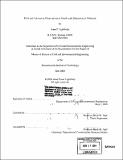| dc.contributor.advisor | Heidi M. Nepf. | en_US |
| dc.contributor.author | Lightbody, Anne F. (Anne Fraser), 1977- | en_US |
| dc.contributor.other | Massachusetts Institute of Technology. Dept. of Civil and Environmental Engineering. | en_US |
| dc.date.accessioned | 2005-10-14T20:13:15Z | |
| dc.date.available | 2005-10-14T20:13:15Z | |
| dc.date.copyright | 2004 | en_US |
| dc.date.issued | 2004 | en_US |
| dc.identifier.uri | http://hdl.handle.net/1721.1/29381 | |
| dc.description | Thesis (S.M.)--Massachusetts Institute of Technology, Dept. of Civil and Environmental Engineering, 2004. | en_US |
| dc.description | Includes bibliographical references (p. 156-160). | en_US |
| dc.description.abstract | Estimating longitudinal dispersion in wetlands is a necessary first step in predicting the behavior of dissolved species and suspended particles. However, many processes are involved, and they can interact in nonlinear ways. Relevant processes include turbulent diffusion, which describes net solute flux created by turbulent eddies. Other dispersive processes result from the retardation of a portion of the solute relative to the rest of a cloud. This retardation can be provided by trapping in the vortex structure behind stems (hold-up dispersion), velocity deficits well downstream of stems (stem-wake dispersion), or transverse gradients in longitudinal velocity (shear dispersion). To better understand the relative magnitude of these various dispersive processes, measurements were taken of velocity, vertical diffusion, and longitudinal dispersion in both the laboratory and the field. Laboratory flume experiments were conducted using an emergent canopy of rigid cylinders with different cylinder densities over depth. Field experiments were conducted in a natural salt marsh. Drag due to local stem density was found to control horizontal velocity in both the lab and field studies over most of the depth. The resulting non-uniform velocity profile generated shear dispersion, which controlled dispersion at longer distances (> 250 cm) downstream of a slug release. For distances < 250 cm downstream, wake shear dispersion was found to be most important. | en_US |
| dc.description.statementofresponsibility | by Anne F. Lightbody. | en_US |
| dc.format.extent | 173 p. | en_US |
| dc.format.extent | 6215149 bytes | |
| dc.format.extent | 6214954 bytes | |
| dc.format.mimetype | application/pdf | |
| dc.format.mimetype | application/pdf | |
| dc.language.iso | eng | en_US |
| dc.publisher | Massachusetts Institute of Technology | en_US |
| dc.rights | M.I.T. theses are protected by copyright. They may be viewed from this source for any purpose, but reproduction or distribution in any format is prohibited without written permission. See provided URL for inquiries about permission. | en_US |
| dc.rights.uri | http://dspace.mit.edu/handle/1721.1/7582 | |
| dc.subject | Civil and Environmental Engineering. | en_US |
| dc.title | Field and laboratory observations of small-scale dispersion in wetlands | en_US |
| dc.type | Thesis | en_US |
| dc.description.degree | S.M. | en_US |
| dc.contributor.department | Massachusetts Institute of Technology. Department of Civil and Environmental Engineering | |
| dc.identifier.oclc | 56124790 | en_US |
